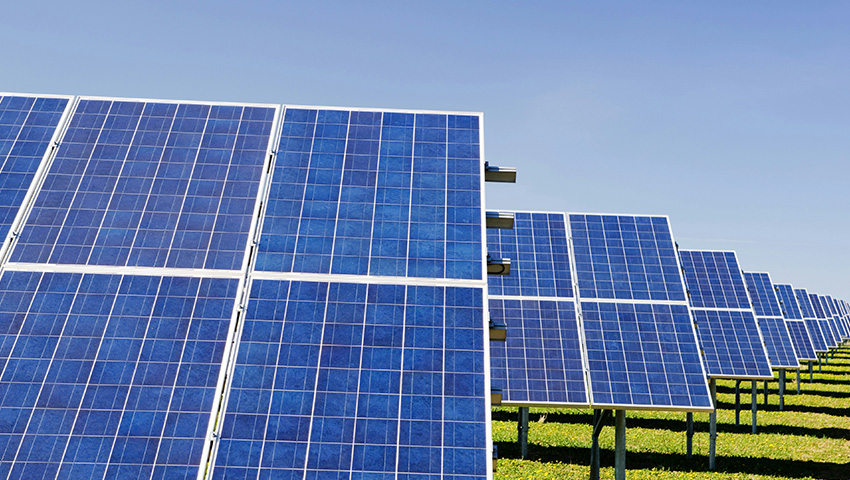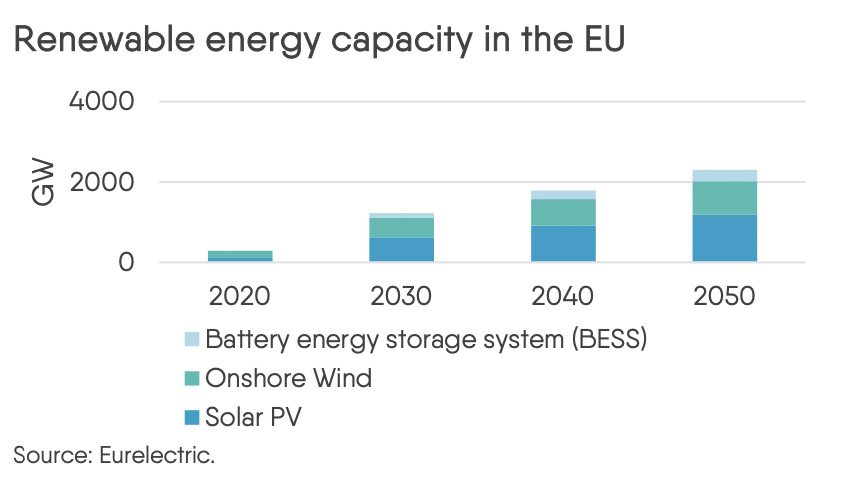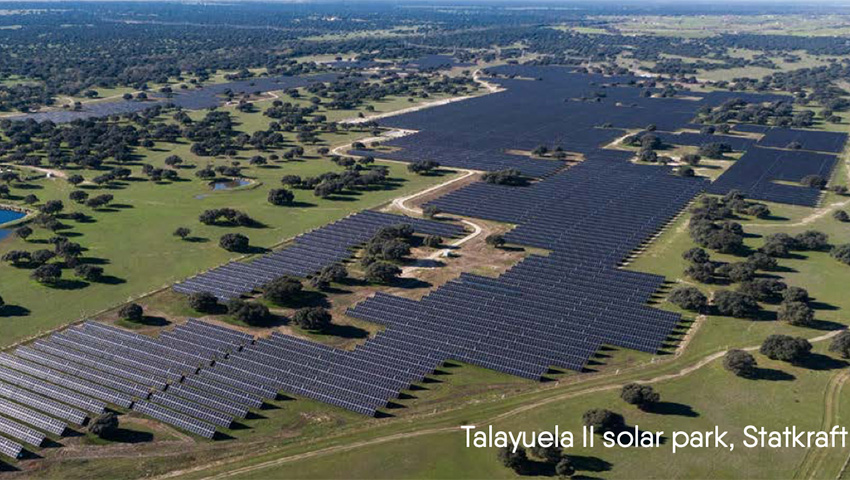What is solar power?

Solar power is today the fastest-growing renewable energy source in Europe as well as globally. At the heart of this technology is photovoltaic energy. Simply put, this is the process of turning sunlight directly into electricity using photovoltaic cells. These cells are made of semiconductor materials, like silicon, which exhibit the photovoltaic effect. The magic of solar power happens when these materials generate an electric current upon exposure to light.
Solar energy itself is not a new concept. It dates back centuries, with ancient civilisations harnessing the sun’s energy. Modern advancements, such as increased efficiency and large-scale solar parks, highlight its potential. Understanding the physics behind photovoltaic energy, from solar irradiance to the photovoltaic effect, reveals the intricate process of generating clean electricity. Despite challenges like seasonal variability, innovative solutions are paving the way for a sustainable future.
But first let’s deep dive into the history of solar power to appreciating its significance today.
What’s the history of solar power?
Today, solar power is heralded as a cutting-edge technological marvel, but humans have been harnessing the sun’s energy since the beginning of time.. The Romans, for instance, incorporated glass into south-facing openings in their buildings to heat and light their rooms. They also constructed makeshift greenhouses as early as 37 AD to cultivate fruit and vegetables for their emperors, making the sun work for them. Similarly, the Greeks, Chinese, and other ancient civilisations strategically designed their structures to utilise the sun’s position, ensuring their buildings remained cool in the summer and warm in the winter.

The photovoltaic effect, a phenomenon where sunlight generates electricity, was discovered by 19-year-old French scientist Edmond Becquerel in 1839. This discovery marked a pivotal moment in the development of solar energy.
Advancements in solar technology were gradual until the 20th century. The first practical solar cell was developed in 1954 using silicon wafers. By 1958, solar cells were employed to power satellites with the Vanguard I satellite utilising a small one-watt panel installed to operate its radios.
Over the past few decades, significant progress has been made in the photovoltaic (PV) technology rendering it far more efficient and cost-effective. Solar power now stands as the third-largest renewable electricity source, following hydropower and wind energy. In 2016, the efficiency of solar cells reached 34.5%, a dramatic improvement from the 6% efficiency achieved in 1954.
Today, solar power is widely commercialised and utilised by millions worldwide to power homes and buildings. Let us now delve into the mechanics of how solar power operates.
How does photovoltaic energy work?
Solar power, or more scientifically, photovoltaic energy, is energy generated from the sun. To understand this process, it is essential to grasp the concept of solar irradiance. Irradiance measures the amount of solar radiation that reaches the Earth’s surface, commonly known as sunlight. It is quantified in watts per square metre, with a total value of approximately 1367 W/m2, known as the solar constant.
In a solar photovoltaic power plant, solar panels convert solar irradiance into electricity through a fascinating process. Here’s how it works: sunlight hits the solar cells in the panel, which are made of silicon. This light contains tiny particles called photons. When photons strike the cell’s silicon, they dislodge electrons, creating an electric current. This entire process is known as the photovoltaic effect.
To maximise exposure to sunlight, these solar panels are mounted on support structures that ensure they are properly tilted and oriented. This positioning is crucial for optimising the efficiency and output of the solar panels. At the core of solar power plants are solar panels. These panels are connected to an inverter, a crucial device that converts the direct current (DC) produced by the panels into alternating current (AC). This conversion is essential because AC is much easier to transport and use in homes. Within the operations of a solar power park, a control system continuously monitors the plant’s performance and ensures its seamless connection to the power grid, guaranteeing that the generated electricity is readily available.
How are solar panels different from photovoltaics?
Contrary to what many might think solar panels and photovoltaics are not the same thing. While panels use solar irradiance to generate energy, photovoltaics convert heat or thermal energy into electricity.
What are the main benefits of solar power plants?
The first benefit of solar energy is its carbon-free nature. Harnessing sunlight does not generate carbon dioxide emissions, nor requires mining fossil fuels.
Another major advantage of solar energy is its versatility in generating electricity through various types of power plants. A particular example is Concentrating Solar Power (CSP) plants, also known as thermodynamic power plants.
What is a concentrating solar power plant?
Unlike traditional photovoltaic panels, CSP plants use mirrors to focus the sun’s rays onto a specific point called a ‘collector’, which contains a heat transfer fluid.
The intense heat from the concentrated sunlight transforms this fluid into steam, which then drives a turbine. This turbine generates mechanical energy, which is subsequently converted into electricity by an alternator. The electricity produced is then ready to be distributed through the power transmission or distribution grid. CSP plants operate similarly to conventional thermal power plants but with the added benefit of using decarbonised renewable solar energy.
Despite significant advancements and numerous benefits, solar energy does come with its challenges. There are still certain drawbacks and bottlenecks that need to be addressed to fully realise its potential. Let’s find out about them.
But what are the downsides of solar?
Solar power is a prime example of effective renewable energy, but it does come with its challenges. The most significant issue with photovoltaic-generated electricity is its seasonal variability. What does this mean? The electricity grid must manage fluctuations in energy demand, which change throughout the day and vary daily.
Solar energy production is subject to predictable day-night cycles, seasonal variations, and less predictable weather conditions. Typically, solar panels generate a surplus of electricity during summer - June, July, and August specifically - and at specific times of the day. This variability known as intermittency poses a challenge for maintaining a stable energy supply.
What is the EU doing about solar energy?
The EU is a firm supporter of this renewable technology and has adopted in recent years several pro-solar legislations and initiatives. Here we list the key ones:
- The EU Renewable Energy Directive (RED) sets a binding target of 42.5% renewable energy in final energy consumption by 2030 and includes faster permitting provisions for solar as well as other incentives to foster demand for renewables electrification.
- The Solar Energy Strategy as part of the EU’s RePowerEU, puts forward a target of over 320 GW of newly installed solar photovoltaic capacity by 2025, and almost 600 GW by 2030. These frontloaded additional capacities are expected to displace the consumption of 9 BCM of natural gas annually by 2027.
- The Electricity Market Design legislation giving a clear path forward for long-term investments into renewables.
With such ambitious targets for solar installation ramping up flexibility is crucial to balance the grid, complement solar variability and ensure a reliable supply of electricity every hour of every day.
Three main solutions to address renewables’ variability
The best way to address the seasonality issue in solar power is by boosting flexible capacity, enhancing storage and battery capacity, foster demand side flexibility, digitalise and expand our grid infrastructure. EU Member States need to integrate these flexible solutions into their energy strategies to meet the growing demand effectively.
How does increasing energy storage help solar development?
Energy storage systems, such as batteries, can significantly mitigate the challenges faced by solar power. These systems store excess electricity generated by solar panels during sunny periods and release it when the sun isn’t shining and demand is higher than supply. This approach helps address the seasonality issue by ensuring a more consistent power supply. Additionally, increasing storage capacity can smooth out variability and fluctuations, providing a steady flow of electricity even during unfavourable weather conditions, thus contributing to a stable and reliable electricity grid.
Expanding and scaling up energy storage is critical. Our Energy Storage paper underscores this urgency, recommending that EU countries conduct economic assessments to determine their flexibility needs and meet them in the most cost-effective manner. A great enabler of storage capacity would be to promote hybridisation, namely integrating solar energy with a battery, or wind projects to reduce variability..
The 24/7 Carbon Free Energy initiative – based on certified hourly matching of clean and renewable energy - exemplifies this approach. It enhances the flexibility and efficiency of renewable energy systems (RES-E) through the combination of batteries with PV panels. This strategy involves using energy storage to shift renewable energy generation to times when it can be consumed, even if generation and consumption are not synchronised. Eurelectric’s 24/7 Business Hub advocates for this approach, demonstrating to a company that it can certify its reduced carbon footprint by aligning clean energy production with consumption whenever feasible.
How does adding new grid capacity help solar installation?
Increasing grid capacity represents a great solution to help combat the seasonality challenge in solar power. By expanding grid infrastructure, more solar energy can seamlessly be integrated into the electricity system. This expansion allows for greater absorption and distribution of solar power without straining existing infrastructure.
Moreover, enhancing grid capacity alleviates congestion on transmission and distribution lines, facilitating more efficient transport of solar energy across regions.. In summary, scaling up grid capacity not only supports the integration of more solar energy but also enhances the resilience and efficiency of the overall electricity network.
Eurelectric’s recent Grids for Speed report reveals significant insights into the future of renewable energy and electricity storage integration. The report forecasts that approximately 70% of upcoming renewable generation and storage capacity will be linked to the distribution grid.
In Europe, distributed renewable capacity is projected to increase nearly six-fold from 2020 to 2050 – confirms Eurelectric’s Decarbonisation Speedways study. Moreover, the rising demand for new connections from renewable projects, solar rooftop PVs, heat pumps, electric vehicles and other distributed energy assets is straining existing electricity grids. New customer connections have increased by 19% in 2022 compared to 2019, underscoring the pressure on grid capacity. In some regions, grids are already at their limits, resulting in delays or refusals for new connection requests.

It is imperative for electricity grids to undergo rapid modernisation and buildout to meet these mounting demands for distributed energy resources (DERs). Ensuring grid adequacy is essential to enable the seamless flow of electricity from production systems to consumption locations. Without sufficient grid capacity, renewable energy production may be curtailed. Therefore, timely and robust energy grid expansion is vital to accommodate and connect the growing capacity of renewable energy sources effectively.
Our estimate for a future-proof and climate resilient distribution grid is of €67 billion per year from 2025 to 2050.
While this may sound like a staggering amount, it pales in comparison to the €451 billion spent by the EU last year on fossil fuel imports – nearly 7 times more than grid investments. And this one year after REPowerEU, which was meant to cut gas consumption across the Bloc by 15%. Europe also spent 1.5 times more on its transport infrastructure – road and rail in 2021. Grids should have their fair share.
How does adding more flexible electrified demand help solar integration?
Expanding flexible electrified demand is crucial for establishing a versatile and robust energy system capable of managing the seasonal variations in solar power. By increasing demand side response, for instance, electric vehicles (EVs) and heat pumps can be programmed to operate when solar power generation is at its peak. This synchronisation is pivotal as it aligns electricity consumption with the availability of solar energy, optimising its use during periods of abundant solar production, particularly in the summer.
Moreover, enhancing flexible electrified demand supports load balancing within the grid. By strategically scheduling the operation of EVs and heat pumps to coincide with high solar output, it reduces strain on the electricity network during peak demand periods. This approach not only maximises the efficiency of solar energy utilisation but also contributes to a more stable and balanced electricity system overall.
When solar power meets biodiversity
The struggle for land use presents a significant challenge in the push for decarbonisation. The Power sector has turned this challenge into an opportunity to reconcile climate action with biodiversity protection and to find synergies across sectors. Eurelectric and WSP created the Biodiversity Integration Guidebook, a comprehensive European-wide resource offering guiding principles an success strategies for integrating biodiversity into solar projects at the ground level.
One notable case study highlighted in the Guidebook demonstrates a successful approach to balancing biodiversity conversation with renewable energy deployment. Statkraft Talayuela 2, a solar power plant operational since 2023 in Spain, exemplifies this approach.

The project was designed not only to harmonise the solar installation with the local landscape but also to protect the area’s holm oak species. Measures were implemented to conserve existing ecosystems, resulting in the preservation of 81 holm oak trees within the project site. This achievement was made possible through a multidisciplinary approach that carefully considered all design and engaged with local actors.
Why is solar power important for Europe?
Solar power stands as the cornerstone of a decarbonised power system, renowned for its rapid deployment compared to other technologies. This characteristic will prove crucial in achieving the ambitious targets set by the EU for 2030 and 2050. According to our decarbonisation speedways study, renewables are projected to dominate the electricity generation mix by 2050. Solar PV technology will leadthe charge, as it's expected to contribute an impressive 28% of total electricity generation by 2050.

To meet these targets, the expansion of solar energy must accelerate significantly beyond historical growth rates. Recognising this critical need, the European Commission’s Solar Energy Strategy has set a target of installing 600 GW of PV capacity by 2030. The International Energy Agency estimates a requirement of 60 GW of new PV installations in 2023 alone to meet escalating demand.
Zooming into the European market status
Turning to the European market in 2023, increased penetration of renewable energy in electricity generation has significantly impacted profitability for renewable assets in recent years. This trend is attributed to rising interest rates, resulting in a notable decline in project fundraising—from €140 billion annually in 2022 to €27 billion in the first nine months of 2023. Despite these financial challenges, annual solar PV installed capacity has shown robust growth from 2000 to 2023, as depicted in the accompanying graph by SolarPower Europe. Germany, Spain, and Italy lead the charge in 2023, with numerous other European countries rapidly catching up, signalling a promising outlook for the solar industry.

Time will tell but the future looks bright
In conclusion, solar power represents a transformative force in the global shift towards renewable energy, combining historical ingenuity with cutting-edge technology. Understanding the intricate workings of photovoltaic cells, the historical advancements, and the modern-day challenges and solutions, such as energy storage, grid expansion, and flexible electrified demand, is fundamental to boost its deployment.
As Europe strives to meet its ambitious renewable energy targets, the rapid installation of new solar projects will be crucial. Solar power is one of the best chances Europe has in combatting climate change. By leveraging the benefits and overcoming the hurdles, we can harness its full potential to create a cleaner, greener world. Time will tell, but the future is looking bright.
